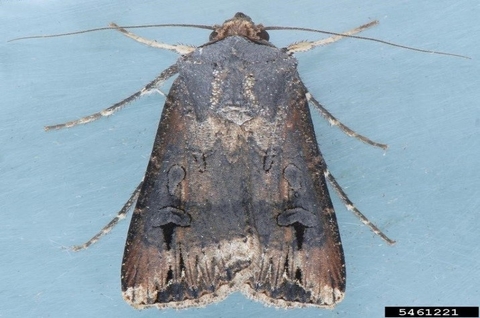One annoying habit, many species
The group of caterpillars, known as cutworms, get their name from an annoying habit many of them share: they feed on young plants right at the soil line, making small plants appear to be “cut” at the base.
The many species and life cycles of cutworms can make it hard to predict what gardens will be at risk. Some species of cutworms live in Minnesota year round. Others can’t survive a Minnesota winter, and hitch a ride up on spring weather fronts. This means that without knowing what kind of species has historically snipped plants in your garden, it is hard to know if your garden is at risk again this year.
Complicating ID is that cutworms are generic looking during almost every part of their lifecycle. Adults are brown, speckled moths, making adults hard to ID. The caterpillars themselves spend the day hiding out in dirt and debris, meaning a) you won’t see them during the day and b) they are meant to blend in. Meaning the caterpillars are brown, tan, gray, or some combination of the three.
Cutworms aren’t showy like monarch caterpillars. The lack of distinct coloration can make them hard to identify as anything beyond a cutworm. ID often relies on looking for tiny bumps, hairs, or characterizing skin texture.
Cutworms do have a calling card: they curl into a C shape when you bother them.
So, what’s a gardener to do?
If you’ve never had a cutworm problem before and want to keep it that way, make your garden unattractive to the moths that lay eggs. Moths are attracted to green plants early in the spring. This means in the garden:
- Remove weeds near and in the garden to eliminate places where moths lay eggs.
- Remove debris near the garden.
- Don’t use green manures in the spring, or if you do, incorporate the plants a few weeks before planting the garden.
If you have had cutworms in the past and want to take active prevention measures, you can use a variety of physical barriers to protect plants:
- Collars made of cardboard or aluminum foil can be placed around plants.
- Squish or drown any cutworm caterpillars you find.
If you don’t want to spend time placing collars, keep an eye out for early cutworm feeding. Cutworms don’t get strong enough to cut plants until they’ve been alive and feeding for a while. If you see small bits of feeding around the edges of leaves, check around the base of plants for cutworms to squish.
Are my plants vulnerable forever?
No! As our garden plants grow, their stems get too big for cutworms to cut. Once plants reach a certain size, you can exhale, as they are too thick for cutworms to chop, and as summer really gets underway cutworms are no longer a garden concern. There are a few species that climb and eat flower buds and fruit, but they are uncommon and cause less damage than early-season cutworms.
For more detailed info on Minnesota’s cutworm species, see the University of Minnesota Extension page on cutworms.



